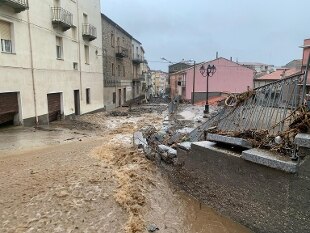Cop26, new events for the climate around the world
Cop 26, Cingolani: "On the climate 194 states that are looking for a solution and democracy, not blah blah"
Climate: UN, new greenhouse gas record
Climate, UN: the last 7 years the hottest ever
Share
November 23, 2021 From 2010 to November 1, 2021, in Italy there are 1,118 extreme events recorded on the climate risk map, 133 in the last year, marking a + 17.2% compared to the previous edition of the report. The most significant impacts were recorded in 602 Italian municipalities, 95 more than last year (almost + 18%). This was revealed in the annual report by the Legambiente City Climate Observatory, produced with the contribution of the Unipol Group and with the scientific collaboration of the Enel Foundation.
Specifically, there were 486 cases of flooding from intense rains, 406 cases of stops in infrastructures due to heavy rains with 83 days of stops in subways and urban trains, 308 events with damage caused by tornadoes, 134 events caused by floods rivers, 48 cases of damage caused by prolonged periods of drought and extreme temperatures, 41 cases of landslides caused by heavy rains and 18 cases of damage to the historical heritage.
As for the cities most affected, the environmental association indicates Rome where, from 2010 to November 1, 2021, 56 events took place, 9 in the last year alone, of which well over half, 32, concerned flooding as a result of rains intense. Another important case is that of Bari with 41 events, mainly flooding from intense rains (20) and damage from tornadoes (18). Milan with 30 total events, where there have been at least 20 floods of the Seveso and Lambro rivers in recent years.
14 the most affected areas between cities and coasts
There are 14 areas in Italy most affected by floods, tornadoes and heat waves, according to the 2021 Report of the Legambiente City Climate Observatory. These are large urban areas and coastal territories: to entire cities such as Rome, Bari, Milan, Genoa and Palermo, the Romagna coast must be added and to the north of the Marche (42 cases), eastern Sicily and the Agrigento coast (38 and 37 extreme events), the metropolitan area of Naples (31 extreme events), western Liguria and the province of Cuneo, with 28 cases in all, ilS alento, with 18 events, the northern Tuscan coast (17), northern Sardinia (12) and the south of the island with 9 cases.
Legambiente recalls that in the areas of eastern Sicily and the Agrigento coast "there were numerous records recorded in 2021: in Syracuse on 11 August, the European record of 48.8 degrees centigrade was reached, in Catania and Syracuse in 48 hours there was a quantity of rain equal to one third of the annual one. Moreover, this part of the island was the scene of devastation following the Medican Apollo ". In Salento, 12 of the 18 events were characterized by tornado damage.
Every year we spend 1.55 billion on emergency management
And speaking of expenses for emergencies, Legambiente reports that according to the data of the Civil Protection, every year we spend 1.55 billion in a ratio of 1 to 5 between costs for prevention and those to repair damage. The environmental association notes that "it is a complex picture, that of our country, of risks and impacts in progress, in which for decades an enormous amount of economic resources has been spent to chase the damage caused by floods, rains and landslides, in the face of few resources spent for prevention. Projects and interventions are then dispersed among the more than ten thousand identified by the Regions, whose usefulness and urgency are not clear ". However, there are "virtuous examples": Turin, which after Bologna and Ancona, on 9 November 2020 approved the "Climate Resilience Plan; Padua, which last June 14 approved the "New Action Plan for sustainable energy and climate" (Paesc), becoming the fourth Italian company to equip itself with a specific tool for the climate. Milan which is implementing a series of innovative projects in the fields of social housing, urban regeneration, smart city and prevention of hydrogeological risks and at the forefront of investments for green roofs.of the smart city and the prevention of hydrogeological risks and at the forefront of investments for green roofs.of the smart city and the prevention of hydrogeological risks and at the forefront of investments for green roofs.

